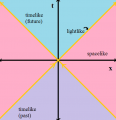File:Relativistic tenses 1.png
Relativistic_tenses_1.png (503 × 521 pixels, file size: 12 KB, MIME type: image/png)
A diagram showing the partitions of spacetime. An observer has a reference frame that is depicted in black, with the time axis being vertical (upward on the screen being futureward) and one dimension of space being the horizontal axis (with the x direction being rightward in the picture). Some point event occurs in this frame of reference and is taken to be the origin. The partitions of spacetime are taken to be for this event. The golden lines that make a 1/8 tau radian (forty-five degree) angle with respect to the black axes represent signals travelling at c_0 (the speed of light) that either could have reached (and therefore caused) the origin event or could have been sent by that event into the universe. This representation (due to the angles aforementioned) imply a special unit parametrization so that 1 unit of space length is essentially equivalent to 1 unit of time duration via definition of c_0 in those units; in particular, this picture uses natural units so that c_0 = 1. Together, the golden lines form a light-cone that separate the timelike-separated region from the spacelike-separated region. Point events that are in the upper blue region are futureward timelike-separated from the origin event and are unambiguously (universally) in its future; they can be caused by it. Events in the lower lavender region are pastward timelike-separated from the origin event and are unambiguously (universally) in its past; they could have caused it. Point events on the gold lines are extreme versions of these- they are the events that occurred at a distance that is maximal for the time required to have been able to cause or to have been able to be caused by the origin event; they are lightlike-separated therefrom; in the frame of reference of the signal, any pair of events that lie on its golden line occur coincidentally (they are in the same place at the same time). For any given pair of strictly timelike-separated events, there is a reference frame in which they occurred at the same spatial location (but, again, they could not be distinct and yet occur at the same time). Point events in the side pink regions are spacelike-separated from the origin event; they could not interact with it in any way. For any pair of strictly spacelike-separated events, there is a reference frame that observes them simultaneously (but not at the same spatial location); their temporal order is entirely dependent on the frame of reference being considered. Lightlike-separation is an extreme version of spacelike-separation as well. See also: https://www.facebook.com/groups/lojban/permalink/10152611805066705/ , http://en.wikipedia.org/wiki/Spacetime#Basic_concepts
File history
Click on a date/time to view the file as it appeared at that time.
| Date/Time | Thumbnail | Dimensions | User | Comment | |
|---|---|---|---|---|---|
| current | 09:38, 5 January 2015 |  | 503 × 521 (12 KB) | Krtisfranks (talk | contribs) | A diagram showing the partitions of spacetime. An observer has a reference frame that is depicted in black, with the time axis being vertical (upward on the screen being futureward) and one dimension of space being the horizontal axis (with the x direc... |
You cannot overwrite this file.
File usage
There are no pages that use this file.
